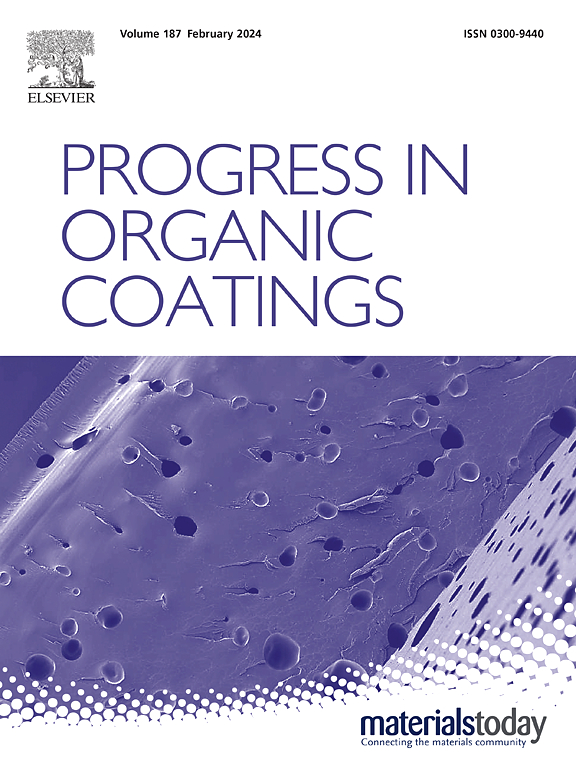通过增强双界面附着力和增强迷宫效应的抗渗透能力,有效提高铝合金基体的抗腐蚀能力
IF 7.3
2区 材料科学
Q1 CHEMISTRY, APPLIED
引用次数: 0
摘要
本文通过在铝合金基体上原位生长以垂直方向为主要取向的层状双氢氧化物(LDH)层的适当粗表面,然后通过静电喷涂在LDH层上沉积以水平方向为主要取向的LDH纳米片为主要取向的氟树脂有机涂层,制备了增强双界面结构。由涂层/LDH中间层/合金衬底组成的双界面结构通过LDH层的原位水热生长机制,形成机械联锁和化学键合(C-O-Mg),实现了显著的附着力保持性提高。在附着力测试中发现,涂层/合金基体单一界面结构上的防腐涂层在刮擦后剥离面积达到16%,在胶带剥落后增加到40%。而双界面结构的防腐涂层没有发生剥离。此外,水平取向覆盖的LDH纳米片所产生的“迷宫效应”比随机分布的纳米片更能有效地延缓水分子(腐蚀性介质)的入侵。因此,与纳米颗粒/氟树脂涂层(2.814 × 105 Ω·cm2)相比,纳米片/氟树脂涂层的|Z|0.1Hz提高了一个数量级,达到1.020 × 106 Ω·cm2。经过5次摩擦循环后,纳米片/氟树脂涂层的水接触角(117.20°)大于纳米片/氟树脂涂层(108.49°),表明纳米片/氟树脂涂层具有更好的机械稳定性。为提高防腐涂层的界面附着力和抗渗透性能,扩大活性金属和轻合金的应用领域提供了可能的策略。本文章由计算机程序翻译,如有差异,请以英文原文为准。

Strategies to improve the anti-corrosion of Al alloy substrate effectively by reinforced double interfacial adhesion and enhanced penetration resistance of labyrinth effect
In this paper, reinforced double interfacial constructions were fabricated by in situ growing appropriate coarse surfaces of layered double hydroxide (LDH) layers in mostly verticals orientation from Al alloy substrate, and then by depositing organic coatings of fluororesin through electrostatic spraying with LDH nanosheets that in mostly horizontal orientation onto LDH layers. The double interface structures consisting of coatings/LDH intermediate layers/alloy substrate realized the remarkable improvement of adhesion retention through the in-situ hydrothermal growth mechanism of LDH layers and the formation of mechanical interlocking and chemical bonding (C-O-Mg). In the adhesion strength tests, it was observed that the stripping areas of anti-corrosion coatings on the single interfacial structure of coatings/alloy substrate reached 16 % after the scratching, and then increased to 40 % after the tape peeling. However, no stripping occurred on the anti-corrosion coatings on the double interfacial structure. Moreover, the “labyrinth effect” produced by LDH nanosheets covered in horizon orientations could delay the invasion of water molecules (corrosive medium) more effectively than that of nanoparticles that in random distribution. Therefore, compared with that of the nanoparticles/fluororesin coating (2.814 × 105 Ω·cm2), the |Z|0.1Hz of the nanosheets/fluororesin coating increased by an order of magnitude, reaching a value of 1.020 × 106 Ω·cm2. After five friction cycles, the nanosheets/fluororesin coating maintained a larger water contact angle (117.20°) than the nanoparticles/fluororesin coating (108.49°), which indicated its superior mechanical stability. The works gave possible strategy enhance interfacial adhesion and permeability resistance of anti-corrosion coatings and enlarge applicable fields for both active metals and light alloys.
求助全文
通过发布文献求助,成功后即可免费获取论文全文。
去求助
来源期刊

Progress in Organic Coatings
工程技术-材料科学:膜
CiteScore
11.40
自引率
15.20%
发文量
577
审稿时长
48 days
期刊介绍:
The aim of this international journal is to analyse and publicise the progress and current state of knowledge in the field of organic coatings and related materials. The Editors and the Editorial Board members will solicit both review and research papers from academic and industrial scientists who are actively engaged in research and development or, in the case of review papers, have extensive experience in the subject to be reviewed. Unsolicited manuscripts will be accepted if they meet the journal''s requirements. The journal publishes papers dealing with such subjects as:
• Chemical, physical and technological properties of organic coatings and related materials
• Problems and methods of preparation, manufacture and application of these materials
• Performance, testing and analysis.
 求助内容:
求助内容: 应助结果提醒方式:
应助结果提醒方式:


